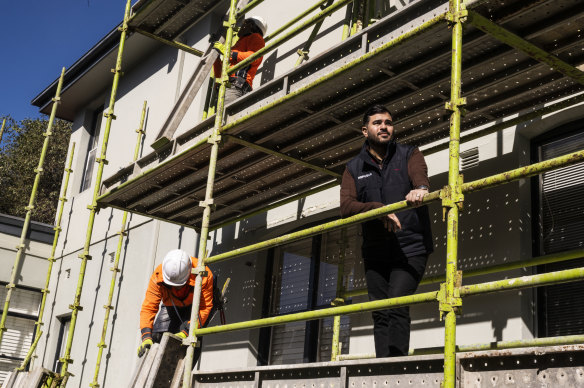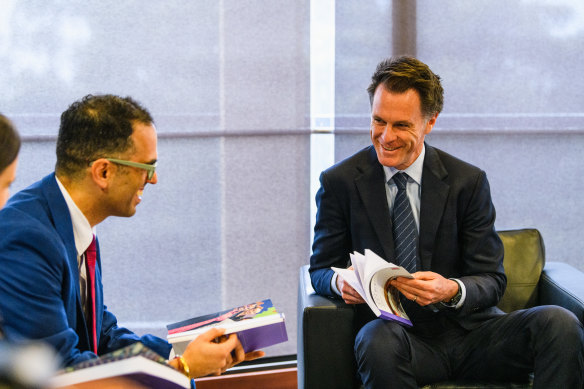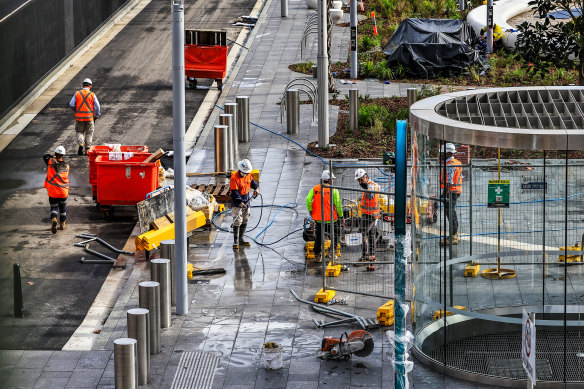- Analysis
- National
- NSW
- Housing crisis
The shocking figure that reveals the depth of Sydney’s housing crisis
By Matt Wade
The number of building company failures in NSW has almost trebled over the past three years, hampering the sector’s capacity to meet ambitious targets to lift housing supply.
Despite record house prices and soaring rents, 1408 NSW construction firms called in administrators during the year to June as inflation and higher interest disrupted the sector.
Around one third of all insolvencies across the state were building companies in that period, figures released by the corporate watchdog, ASIC, show.
Timothy Hibbert, head of property and building forecasting for Oxford Economics Australia, said NSW has been at the “epicentre” of stress in the building industry.
“Construction sector administrations are sky high in NSW,” he said. “It’s a big stand-out on a state by state basis.”
Nearly half of all building firms that failed nationally in the year to June were in NSW.

Mohammed Sheeth, owner of Republic Building Co, at one of his firm’s jobsCredit: Photo: Louise Kennerley SMH
Inflation and higher rates
Mohammed Sheeth, owner of Republic Building Co, a Sydney construction firm with 10 staff, says a post-COVID spike in building costs and the spate of interest rate increases between May 2022 and November 2023, have caused havoc, especially for smaller firms.
“All of a sudden builders had to have conversations with their clients about contract variations caused by higher costs,” he said.
A damaging spiral followed: when builders negotiated price variations with clients, many were unable to increase borrowings to cover the extra costs, because of higher interest rates.
“That created a huge issue where people had to work as hard as they could, often without profit, just trying to finish those live projects,” Sheeth said.
Many desperate firms were forced to cut prices to win additional work.
“It’s become this wild rat race with people trying to win work because they need to survive and feed their families,” says Sheeth. “A lot of businesses went under.”
Republic Building Co has weathered the storm, but Sheeth says it has “been very challenging”.
The NSW budget, delivered in June, underscored the difficulties facing home builders. It warned that higher interest rates and construction costs, combined with delays due to a lack of labour and materials, were “compressing construction sector margins” especially for larger residential projects.
“These factors have negatively impacted the feasibility of new residential projects, contributing to a sharp decline in the number of dwelling approvals, on a trend basis, over the past year to their lowest level in a decade,” the budget said. “These pressures have also seen a rise in construction insolvencies, which may delay any recovery in construction activity.”
Premier Chris Minns has made lifting the supply of new dwellings a top priority; the centrepiece of the budget was a $5.1 billion housing package which includes the largest state-based investment in social housing in the state’s history.
In May, the government announced a target to build 377,000 new homes in NSW over the next five years, 70 per cent of them in Sydney. Executive director of the Master Builders Association of NSW Brian Seidler expects at least half of the state’s new housing supply to be apartments.

Treasurer Daniel Mookhey and Premier Chris Minns with copies of this year’s NSW Budget, which had housing supply at the centre of it.Credit: James Brickwood
But the incentive for developers to build apartments has been affected by the spike in construction costs and higher interest rates that followed COVID-19 disruptions.
KPMG urban economist Terry Rawnsley says high density residential development has become less viable across “whole swaths” of the city.
“The places where the supply has really dried up is in those more fringe apartment markets where the price at which you can sell a new apartment into the market hasn’t changed much, but the cost of construction has gone up by about 30 per cent,” he said.
Research by Peter Tulip, chief economist at the Centre for Independent Studies, found in council areas across Sydney’s eastern suburbs, north shore and northern beaches the sale price of new apartments was between 40-60 per cent above the cost of supplying those apartments. In Randwick, the gap between the cost of supplying apartments and the sale price was 53 per cent, the highest of any council area.
However, in much of west and south-west Sydney, apartment sale prices were only 8-11 per cent above the cost of supply, and in the Liverpool council area apartment sale prices were three per cent lower than the cost of supply.
Tulip blames council planning rules for stymying new housing development in well-located suburbs in Sydney’s east and north where consumer demand is strong.
“That restriction of supply, in the face of steadily rising demand, is why housing in those areas is so expensive,” he said.
Building and the Sydney economy
The construction industry employs about 275,000 Sydneysiders or just over nine per cent of the workforce. That makes it the city’s third-largest employer behind Health Care and Social Assistance (426,000) and Professional, Scientific and Technical Services (398,000).
The sector includes a diverse range of occupations ranging from heavy engineering services to bricklayers, tilers, painters and glaziers. Analysis of census data by social research firm McCrindle shows traditional trades were among the biggest sources of employment including electricians (11 per cent), plumbers (seven per cent) and carpenters (seven per cent).
While property development has emerged as one of Sydney’s most prominent industries, and the source of many fortunes, the building industry relies heavily on small businesses, especially residential construction.
“We often think of it an industry dominated by large players but in fact the sector is dominated by small businesses and subcontractors,” says demographer Mark McCrindle.
During the past five years building new homes has accounted for a bit over half the value of new building work done in Sydney (in 2022-23 housing made up 54 per cent of the value of new approvals across the city). The remainder was for non-residential projects including commercial and public buildings.
Around 60 per cent of Sydney’s new completions were medium and high density housing in that period.
Despite the ongoing political debate about housing policy, the supply of new dwellings is lagging.
New home completions in Sydney peaked in 2018-19 at just over 56,000. But forecasters expect that fell to about 29,600 last financial year, the lowest in a decade.
Oxford Economics forecaster Tim Hibbert predicts that annual housing completions in Sydney will slide even further, to just 27,337 in 2026-27, before recovering later in the decade.
He attributes this to prolonged weakness in building approvals and the long lag times for large high density developments which now dominate housing construction in Sydney.
Hibbert says the post-COVID spike in construction costs and higher rates remain “headwinds” for home building.
Need for skilled workers
Seidler warns that a shortage of skilled builders will also hamper efforts to ramp up Sydney’s supply of new housing.
“If the industry is not producing enough builders, it doesn’t matter how fast your planning system is,” he said.
McCrindle’s analysis reveals that employment in big infrastructure projects grew far more quickly in Sydney between 2016 and 2021 than in residential construction; the number of jobs in heavy and civil engineering surged 52 per cent in that period compared with employment growth of 19 per cent in house construction.
“The data indicates there has been a flow of personnel and skills towards infrastructure and non-residential construction and away from residential,” says McCrindle.
‘If we want housing to be affordable, we need to allow more building.’
Economist Peter Tulip
Seidler says apprentices who have trained in residential construction can get pay increases of 30-50 per cent to take up jobs in infrastructure or commercial construction.
“That means the residential sector gets starved of up-and-coming workers,” he says.
Ultimately, that will affect the sector’s capacity to efficiently lift housing supply.
The NSW government argues more skilled construction workers will become available for home building as major public works projects such as Metro City and Southwest begin to wind down.

Construction workers on the Barangaroo Sydney Metro station.Credit: Getty Images
Tulip also points out that Sydney’s building industry managed to deliver around 30 per cent more dwellings in 2019 that it did last year.
“It’s difficult to believe that all of those bricklayers and plumbers have disappeared, so if we can build 30 per cent more housing a few years ago, we should be able to return to that now,” he said.
Tulip argues that housing supply would be much higher if planning rules were less restrictive, especially in well-located suburbs where demand is high.
“Even given current market conditions there is an enormous amount of extra housing that builders would very willingly supply,” he said. “If we want housing to be affordable, we need to allow more building.”
Despite the challenges since the COVID-19 disruptions, Seidler believes there are “massive opportunities” for Sydney’s builders.
“The amount of work in the pipeline is extraordinary, both residential and commercial,” he said.
Start the day with a summary of the day’s most important and interesting stories, analysis and insights. Sign up for our Morning Edition newsletter.